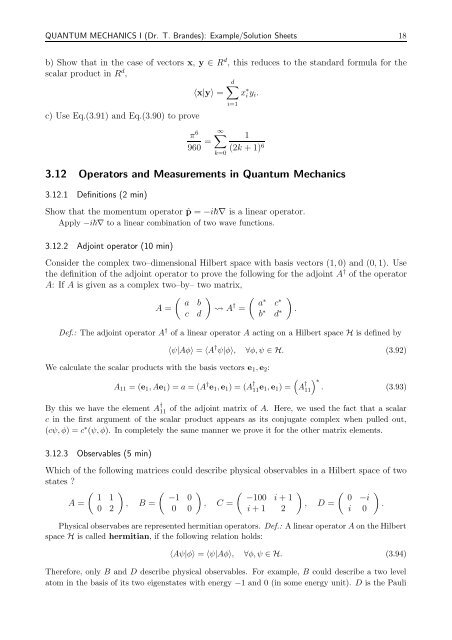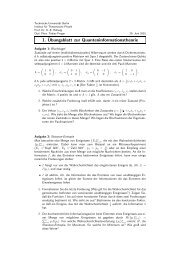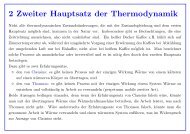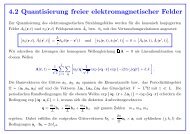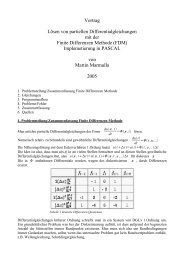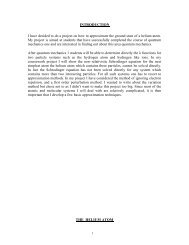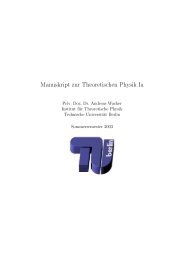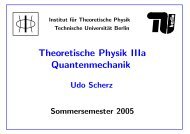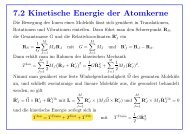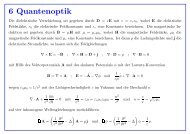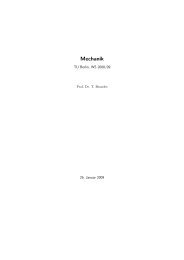1.1 The Radiation Laws and the Birth of Quantum Mechanics
1.1 The Radiation Laws and the Birth of Quantum Mechanics
1.1 The Radiation Laws and the Birth of Quantum Mechanics
Create successful ePaper yourself
Turn your PDF publications into a flip-book with our unique Google optimized e-Paper software.
QUANTUM MECHANICS I (Dr. T. Br<strong>and</strong>es): Example/Solution Sheets 18<br />
b) Show that in <strong>the</strong> case <strong>of</strong> vectors x, y ∈ R d , this reduces to <strong>the</strong> st<strong>and</strong>ard formula for <strong>the</strong><br />
scalar product in R d ,<br />
d∑<br />
〈x|y〉 = x ∗ i y i .<br />
c) Use Eq.(3.91) <strong>and</strong> Eq.(3.90) to prove<br />
i=1<br />
π 6 ∞<br />
960 = ∑ 1<br />
(2k + 1) 6<br />
3.12 Operators <strong>and</strong> Measurements in <strong>Quantum</strong> <strong>Mechanics</strong><br />
3.12.1 Definitions (2 min)<br />
Show that <strong>the</strong> momentum operator ˆp = −i∇ is a linear operator.<br />
Apply −i∇ to a linear combination <strong>of</strong> two wave functions.<br />
3.12.2 Adjoint operator (10 min)<br />
k=0<br />
Consider <strong>the</strong> complex two–dimensional Hilbert space with basis vectors (1, 0) <strong>and</strong> (0, 1). Use<br />
<strong>the</strong> definition <strong>of</strong> <strong>the</strong> adjoint operator to prove <strong>the</strong> following for <strong>the</strong> adjoint A † <strong>of</strong> <strong>the</strong> operator<br />
A: If A is given as a complex two–by– two matrix,<br />
( ) ( )<br />
a b<br />
a<br />
A = A † ∗<br />
c<br />
=<br />
∗<br />
c d<br />
b ∗ d ∗ .<br />
Def.: <strong>The</strong> adjoint operator A † <strong>of</strong> a linear operator A acting on a Hilbert space H is defined by<br />
We calculate <strong>the</strong> scalar products with <strong>the</strong> basis vectors e 1 , e 2 :<br />
〈ψ|Aφ〉 = 〈A † ψ|φ〉, ∀φ, ψ ∈ H. (3.92)<br />
A 11 = (e 1 , Ae 1 ) = a = (A † e 1 , e 1 ) = (A † 11 e 1, e 1 ) =<br />
(<br />
A † 11) ∗<br />
. (3.93)<br />
By this we have <strong>the</strong> element A † 11 <strong>of</strong> <strong>the</strong> adjoint matrix <strong>of</strong> A. Here, we used <strong>the</strong> fact that a scalar<br />
c in <strong>the</strong> first argument <strong>of</strong> <strong>the</strong> scalar product appears as its conjugate complex when pulled out,<br />
(cψ, φ) = c ∗ (ψ, φ). In completely <strong>the</strong> same manner we prove it for <strong>the</strong> o<strong>the</strong>r matrix elements.<br />
3.12.3 Observables (5 min)<br />
Which <strong>of</strong> <strong>the</strong> following matrices could describe physical observables in a Hilbert space <strong>of</strong> two<br />
states <br />
( ) ( ) ( ) ( )<br />
1 1<br />
−1 0<br />
−100 i + 1<br />
0 −i<br />
A = , B =<br />
, C =<br />
, D =<br />
.<br />
0 2<br />
0 0<br />
i + 1 2<br />
i 0<br />
Physical observabes are represented hermitian operators. Def.: A linear operator A on <strong>the</strong> Hilbert<br />
space H is called hermitian, if <strong>the</strong> following relation holds:<br />
〈Aψ|φ〉 = 〈ψ|Aφ〉, ∀φ, ψ ∈ H. (3.94)<br />
<strong>The</strong>refore, only B <strong>and</strong> D describe physical observables. For example, B could describe a two level<br />
atom in <strong>the</strong> basis <strong>of</strong> its two eigenstates with energy −1 <strong>and</strong> 0 (in some energy unit). D is <strong>the</strong> Pauli


